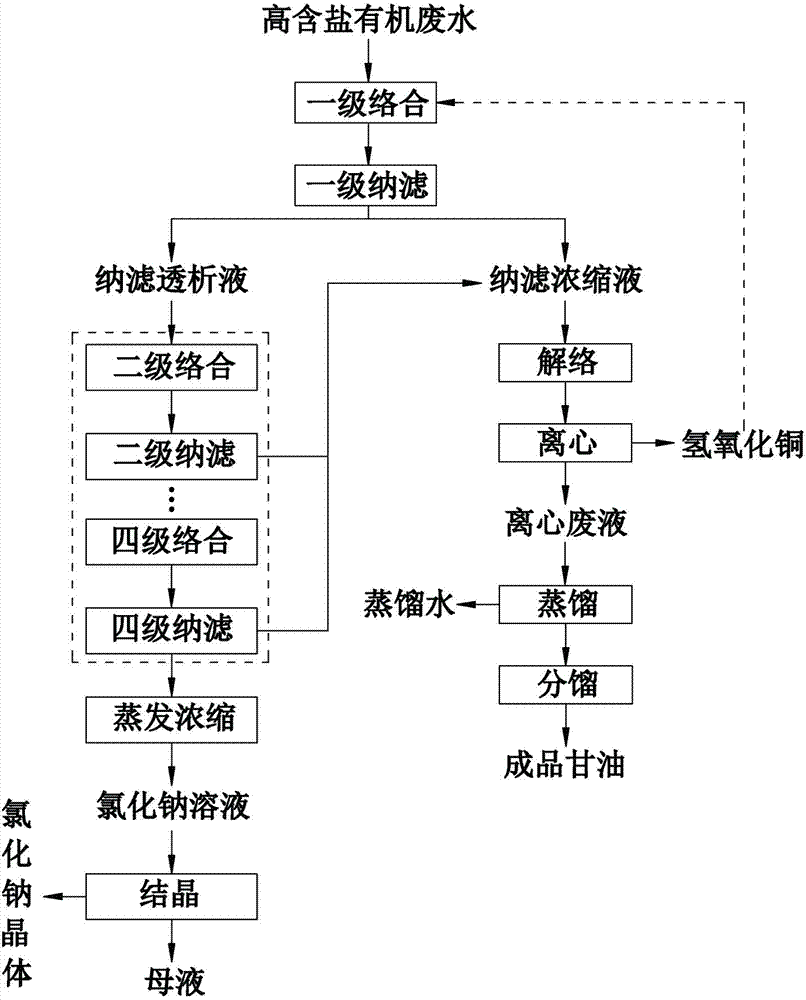Method for recycling glycerol in organic wastewater with high salt content
A technology of organic waste water and recovery method, applied in the preparation of organic compounds, organic chemistry, chemical instruments and methods, etc., can solve the problems of waste of resources, pollute the environment, and have not been recycled, and achieve the effect of ensuring feasibility
- Summary
- Abstract
- Description
- Claims
- Application Information
AI Technical Summary
Problems solved by technology
Method used
Image
Examples
Embodiment 1
[0045] Recover sodium chloride and glycerin from wastewater containing 30% sodium chloride and 2% glycerol.
[0046] (1) Primary complexation
[0047] Sodium hydroxide solution and copper sulfate solution are added to high-salt organic wastewater, so that glycerol contained in the wastewater undergoes a complex reaction with copper ions under alkaline conditions to form a negative divalent glycerol copper complex.
[0048] (2) Primary nanofiltration desalination
[0049] Step (1) The waste water after the complexation treatment is desalted by graded filtration through the nanofiltration membrane to obtain the nanofiltration concentrate containing glycerin copper and the nanofiltration dialysate containing sodium chloride. The dialysate contains 19% sodium chloride, and the menstrual fluid Phase chromatographic analysis showed that the glycerin content was 350mg / L. In order to ensure that the nanofiltration membrane is not polluted, before nanofiltration desalination, an ultraf...
Embodiment 2
[0065] Recover sodium chloride and glycerin from waste water containing 18% sodium chloride and 20% glycerin.
[0066] (1) Primary complexation
[0067] Add alkali hydroxide and copper hydroxide newly made from copper sulfate into the high-salt organic wastewater, and keep stirring, so that the glycerol contained in the wastewater undergoes a complex reaction with copper hydroxide under alkaline conditions to form a negative divalent Glycerol Copper Complex.
[0068] (2) Primary nanofiltration desalination
[0069] The waste water after the primary complexation treatment in step (1) is desalted by graded filtration through a nanofiltration membrane to obtain a nanofiltration concentrate containing copper glycerol and a nanofiltration dialysate containing 15% sodium chloride and 8% glycerin. In order to ensure that the nanofiltration membrane is not polluted, before nanofiltration desalination, a microfiltration device is added to remove large particles of impurities to obtai...
Embodiment 3
[0098] Recover sodium chloride and glycerin from waste water containing 22% sodium chloride and 12% glycerin.
[0099] (1) Primary complexation
[0100] Sodium hydroxide solution and copper sulfate solution are added to high-salt organic wastewater, so that the glycerin contained in the wastewater undergoes a complex reaction with copper ions under alkaline conditions to form a glycerol-copper complex.
[0101] (2) One-stage nanofiltration desalination (separation of copper glycerol and salt)
[0102] The waste water after the complexation treatment in step (1) is desalted by graded filtration through a nanofiltration membrane to obtain a nanofiltration concentrate containing copper glycerol and a nanofiltration dialysate containing 17% sodium chloride and 4% glycerin.
[0103] The above-mentioned nanofiltration membrane adopts a nanofiltration membrane with a rejection rate of 98% for magnesium sulfate. The nanofiltration membrane is any one of grades 1-4, and the membrane m...
PUM
 Login to View More
Login to View More Abstract
Description
Claims
Application Information
 Login to View More
Login to View More - R&D
- Intellectual Property
- Life Sciences
- Materials
- Tech Scout
- Unparalleled Data Quality
- Higher Quality Content
- 60% Fewer Hallucinations
Browse by: Latest US Patents, China's latest patents, Technical Efficacy Thesaurus, Application Domain, Technology Topic, Popular Technical Reports.
© 2025 PatSnap. All rights reserved.Legal|Privacy policy|Modern Slavery Act Transparency Statement|Sitemap|About US| Contact US: help@patsnap.com

